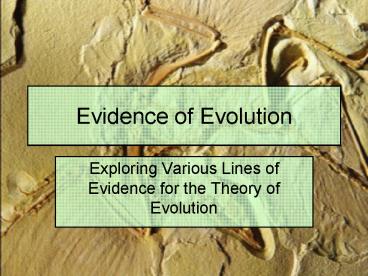Evidence of Evolution - PowerPoint PPT Presentation
1 / 31
Title:
Evidence of Evolution
Description:
Species that are more closely related tend to have more similarities in their DNA ... that give birth to live young that develop in an outer pouch of the mother. ... – PowerPoint PPT presentation
Number of Views:93
Avg rating:3.0/5.0
Title: Evidence of Evolution
1
Evidence of Evolution
- Exploring Various Lines of Evidence for the
Theory of Evolution
2
Lines of Evidence
- DNA Sequences
- Comparative Anatomy
- Embryology
- Transitional Fossils
- Biogeography
- Genetic Tool Kit
3
DNA Sequences
- Scientists are able to isolate pieces of DNA and
determine the actual sequence of nucleotides - Species that are more closely related tend to
have more similarities in their DNA
4
DNA Sequences
- Leptin protein hormone that is important for
regulating body weight and metabolism - Mice without properly functioning leptin gene are
morbidly obese (right) compared to normal mice
(left) - Leptin protein
5
DNA Sequences
- Compare actual sequences of DNA (leptin gene)
between three different species human,
chimpanzee, mouse - Predictions how much similarity will there be?
Who will be most closely related?
6
DNA Sequences
- First 60 nucleotides
- Human gtaggaatcg cagcgccagc ggttgcaagg
taaggccccg gcgcgctcct tcctccttct - Chimp gtaggaatcg cagcgccagc ggttgcaagg
taaggccccg gcgcgctcct tcctccttct - Mouse gaggga tcc ctgctccagc agctgcaagg
taaggcccggggcgcgctact ttctcctcca - (Mouse sequence has been shifted to line up as
much as possible.) - REMEMBER Mutations can arise in the DNA sequence
in a variety of forms, including nucleotide
replacement, insertion, deletion, sequence
inversion, etc.
7
DNA Sequences
- Nucleotides 121-180
- Human agtcaggagg gatgcagggc ggatggctta
gttctggact atgatagctt tgtaccgagt - Chimp agtcaggagg gaggcagggc ggatggctta
gttctggact atgatagctt tgtaccgagt - Mouse aggtcatgtg gacagcttgg tgttgaattc
agtagttttg cagcgaggga ctctgcagac - Note how the mouse sequence compares, after so
many mutations have accumulated. - REMEMBER Mutations can arise in the DNA sequence
in a variety of forms, including nucleotide
replacement, insertion, deletion, sequence
inversion, etc. - (Human and Chimp sequences are identical between
nucleotides 61-120.)
8
Comparative Anatomy
- Similarities in structures between species
suggest they descended from a common ancestor. - Note the color-coded bones for the limbs of these
4 mammals though different, they share many
similar bones. Describe the function of each
animals limb on your handout.
9
Comparative Anatomy
- http//www.eskeletons.org/
- Click Comparative Anatomy link
- Compare human, chimpanzee, and squirrel monkey
- Predictions Who would be the most similar and
why? What similarities and differences might you
expect? - Follow the directions on your handout!
10
Embryology
Ernst von Baer (1828) the more closely related
any two species are, the more similar their
development as embryos. In this game, you will
look at pictures of embryos and guess what animal
it is. Is it a snake, chicken, possum, cat, bat
or human? Write your guess down on your handout,
before you look at the answer!
11
Embryology
Are you sure thats your prediction?
Snake!
12
Embryology
Are you sure thats your prediction?
Bat!
13
Embryology
Are you sure thats your prediction?
Cat!
14
Embryology
Are you sure thats your prediction?
Chicken!
15
Embryology
Are you sure thats your prediction?
Human!
16
Embryology
Are you sure thats your prediction?
Possum!
17
(No Transcript)
18
Biogeography
- Marsupial distribution across the globe
http//evolution.berkeley.edu/evolibrary/article/0
_0_0/lines_11 - Distribution today split on two sides of globe
how? - Review a few facts of the distribution and
marsupials, as well as the history of the Earth,
then formulate hypothesis behind distribution
Biogeography is the study of the large-scale or
global pattern of distribution of species,
including the history and causes of this
distribution. For this activity, you will
explore the history and cause behind the
distribution of marsupials.
19
Biogeography
- Marsupial distribution across the globe
http//evolution.berkeley.edu/evolibrary/article/0
_0_0/lines_11 - Distribution today split on two sides of globe
how? - Review a few facts of the distribution and
marsupials, as well as the history of the Earth,
then formulate hypothesis behind distribution
Marsupials are a group of mammals that give birth
to live young that develop in an outer pouch of
the mother.
Bandicoot
Koala
Opossum
Sugar Glider
Kangaroo
20
Biogeography
There is no evidence of any marsupials able to
swim across the ocean. No marsupial has been
observed wandering across the Asian mainland.
There does not appear to be any route of
migration between the two populations of
marsupials. How do you think some marsupials
ended up halfway across the world from the
others?
21
Biogeography
Continental Drift over millions of years watch
the movement of land masses
22
Biogeography
Continental Drift Distribution of Marsupials
23
Biogeography
Similar reptilian Mesosaurus fossils found in
both South America and Africa ? evidence of
continental drift (couldnt swim the ocean, no
land bridge ? continents once joined)
24
Biogeography
Similar reptilian Mesosaurus fossils found in
both South America and Africa (couldnt swim the
ocean, no land bridge) ? evidence of continental
drift (continents once joined)
25
Transitional Fossils
- Archaeopteryx fossils multiple specimen found in
limestone in Germany
26
Archaeopteryx Berlin specimen
27
Archaeopteryx Eichstatt specimen
28
Archaeopteryx Solnhofen specimen
29
Whale Evolution
- Video about the transitional forms in the
evolution of whales mammals evolving from land
back to sea - http//www.pbs.org/wgbh/evolution/library/03/4/l_0
34_05.html
30
Genetic Tool Kit
- Video about Homeobox genes and implications for
evolution - http//www.pbs.org/wgbh/evolution/library/03/4/l_0
34_04.html - Answer the questions on your handout
31
Eye Evolution
- Video about the evolution of the eye
- http//www.pbs.org/wgbh/evolution/library/01/1/l_0
11_01.html - Answer the questions on your handout































